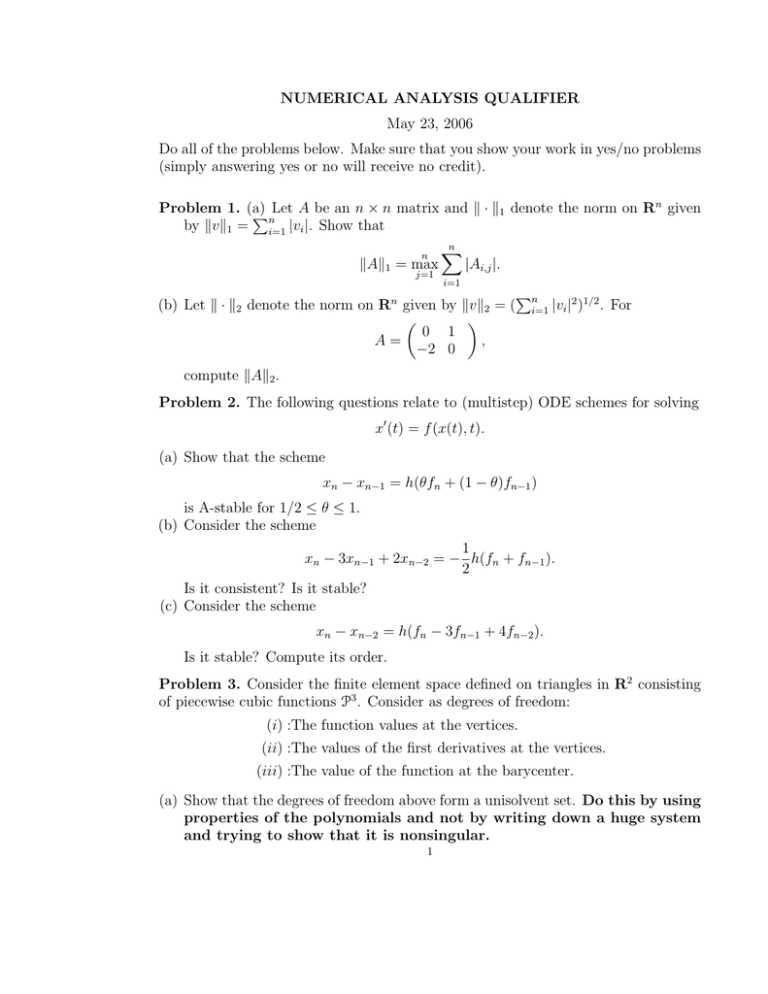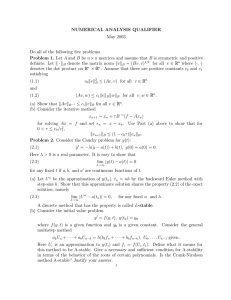NUMERICAL ANALYSIS QUALIFIER May 23, 2006
advertisement

NUMERICAL ANALYSIS QUALIFIER May 23, 2006 Do all of the problems below. Make sure that you show your work in yes/no problems (simply answering yes or no will receive no credit). n Problem 1. (a) PnLet A be an n × n matrix and k · k1 denote the norm on R given by kvk1 = i=1 |vi |. Show that n kAk1 = max j=1 n X |Ai,j |. i=1 P (b) Let k · k2 denote the norm on R given by kvk2 = ( ni=1 |vi |2 )1/2 . For 0 1 , A= −2 0 n compute kAk2 . Problem 2. The following questions relate to (multistep) ODE schemes for solving x′ (t) = f (x(t), t). (a) Show that the scheme xn − xn−1 = h(θfn + (1 − θ)fn−1 ) is A-stable for 1/2 ≤ θ ≤ 1. (b) Consider the scheme 1 xn − 3xn−1 + 2xn−2 = − h(fn + fn−1 ). 2 Is it consistent? Is it stable? (c) Consider the scheme xn − xn−2 = h(fn − 3fn−1 + 4fn−2 ). Is it stable? Compute its order. Problem 3. Consider the finite element space defined on triangles in R2 consisting of piecewise cubic functions P3 . Consider as degrees of freedom: (i) :The function values at the vertices. (ii) :The values of the first derivatives at the vertices. (iii) :The value of the function at the barycenter. (a) Show that the degrees of freedom above form a unisolvent set. Do this by using properties of the polynomials and not by writing down a huge system and trying to show that it is nonsingular. 1 2 (b) State a theorem which provides a criterion that you can apply to determine when an assembled finite element space is H 1 -conforming. (c) Show that the assembled finite element space corresponding to this problem is H 1 -conforming. (d) Prove or disprove: The assembled finite element space corresponding to this problem is H 2 -conforming. Problem 4. Consider the one dimensional wave equation, ζtt − ζxx = 0, for (x, t) ∈ (0, 1) × (0, T ], (4.1) ζ(0, t) = ζ(1, t) = 0, for t ∈ (0, 1], ζ(x, 0) = ζ0 (x), ζt (x, 0) = η0 (x), for x ∈ [0, 1]. (a) Describe the (time continuous) semi-discrete approximation to (4.1) based on finite differences on a uniform grid in space consisting of m internal nodes. (b) The semi-discrete method of Part (a) above can be written as a system of ODEs of the form Ztt + AZ = 0, for t > 0 Z(0) = Z0 , Zt (0) = N0 . Here Z(t), Z0 , N0 ∈ R , A is a symmetric and positive definite m × m matrix, and Z0 (resp. N0 ) interpolates ζ0 (resp. η0 ). Let N = Zt then the above system leads to the first order system m (4.2) Nt + AZ = 0, Zt − N = 0. Consider the following fully discrete scheme for (4.2) with step-size k: Zn+1 − Zn k − Nn + AZn+1 = 0, k 2 (4.3) Nn+1 − Nn + AZn+1 = 0. k Show that Zk satisfies a three term recurrence by eliminating N . (c) Show that (4.3) is unconditionally stable by using the three term relation of Part (b) above and expanding in terms of the eigenvectors of A.











